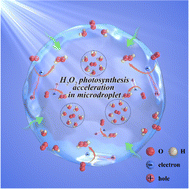Highly efficient photocatalytic H2O2 production in microdroplets: accelerated charge separation and transfer at interfaces†
Abstract
Solar-driven H2O2 production is a promising approach for addressing both the energy and environmental crises. However, H2O2 photosynthesis is still restricted by insufficient electron–hole separation efficiency (ηsep) and sluggish semiconductor/solution interface charge transfer efficiency (ηtrans). Here, we found that microdroplet photocatalysis showed an ultrahigh H2O2 evolution rate (20.6 mmol gcat−1 h−1) and performance enhancement of two orders of magnitude compared to the corresponding bulk phase counterpart. Microdroplet size effects and in situ Raman measurements on individual microdroplets demonstrated the faster photocatalytic reaction rates in smaller microdroplets and at microdroplet air–water interfaces (AWIs). Besides the sufficient O2 availability, vibrational Stark effect measurements and DFT calculations revealed that the ultra-strong electric field and partial solvation at microdroplet AWIs could improve ηsep and ηtrans, synergistically leading to significant H2O2 photosynthesis acceleration. As a proof-of-concept, the in situ applicability of microdroplet H2O2 photosynthesis was demonstrated. This study highlights the prospects of microdroplets for accelerating semiconductor photocatalysis.



 Please wait while we load your content...
Please wait while we load your content...